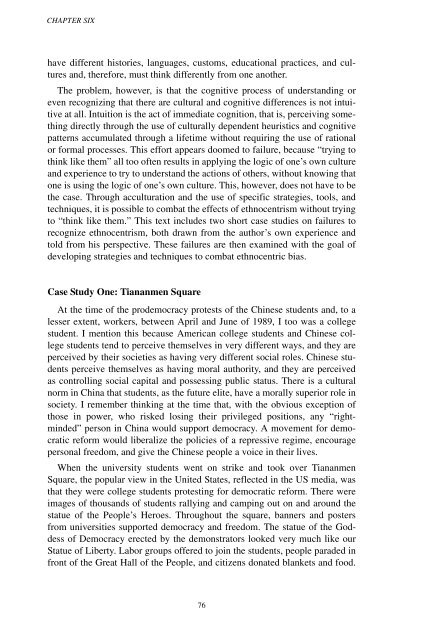Analytic Culture in the U.S. Intelligence Community (PDF) - CIA
Analytic Culture in the U.S. Intelligence Community (PDF) - CIA
Analytic Culture in the U.S. Intelligence Community (PDF) - CIA
Create successful ePaper yourself
Turn your PDF publications into a flip-book with our unique Google optimized e-Paper software.
CHAPTER SIX<br />
have different histories, languages, customs, educational practices, and cultures<br />
and, <strong>the</strong>refore, must th<strong>in</strong>k differently from one ano<strong>the</strong>r.<br />
The problem, however, is that <strong>the</strong> cognitive process of understand<strong>in</strong>g or<br />
even recogniz<strong>in</strong>g that <strong>the</strong>re are cultural and cognitive differences is not <strong>in</strong>tuitive<br />
at all. Intuition is <strong>the</strong> act of immediate cognition, that is, perceiv<strong>in</strong>g someth<strong>in</strong>g<br />
directly through <strong>the</strong> use of culturally dependent heuristics and cognitive<br />
patterns accumulated through a lifetime without requir<strong>in</strong>g <strong>the</strong> use of rational<br />
or formal processes. This effort appears doomed to failure, because “try<strong>in</strong>g to<br />
th<strong>in</strong>k like <strong>the</strong>m” all too often results <strong>in</strong> apply<strong>in</strong>g <strong>the</strong> logic of one’s own culture<br />
and experience to try to understand <strong>the</strong> actions of o<strong>the</strong>rs, without know<strong>in</strong>g that<br />
one is us<strong>in</strong>g <strong>the</strong> logic of one’s own culture. This, however, does not have to be<br />
<strong>the</strong> case. Through acculturation and <strong>the</strong> use of specific strategies, tools, and<br />
techniques, it is possible to combat <strong>the</strong> effects of ethnocentrism without try<strong>in</strong>g<br />
to “th<strong>in</strong>k like <strong>the</strong>m.” This text <strong>in</strong>cludes two short case studies on failures to<br />
recognize ethnocentrism, both drawn from <strong>the</strong> author’s own experience and<br />
told from his perspective. These failures are <strong>the</strong>n exam<strong>in</strong>ed with <strong>the</strong> goal of<br />
develop<strong>in</strong>g strategies and techniques to combat ethnocentric bias.<br />
Case Study One: Tiananmen Square<br />
At <strong>the</strong> time of <strong>the</strong> prodemocracy protests of <strong>the</strong> Ch<strong>in</strong>ese students and, to a<br />
lesser extent, workers, between April and June of 1989, I too was a college<br />
student. I mention this because American college students and Ch<strong>in</strong>ese college<br />
students tend to perceive <strong>the</strong>mselves <strong>in</strong> very different ways, and <strong>the</strong>y are<br />
perceived by <strong>the</strong>ir societies as hav<strong>in</strong>g very different social roles. Ch<strong>in</strong>ese students<br />
perceive <strong>the</strong>mselves as hav<strong>in</strong>g moral authority, and <strong>the</strong>y are perceived<br />
as controll<strong>in</strong>g social capital and possess<strong>in</strong>g public status. There is a cultural<br />
norm <strong>in</strong> Ch<strong>in</strong>a that students, as <strong>the</strong> future elite, have a morally superior role <strong>in</strong><br />
society. I remember th<strong>in</strong>k<strong>in</strong>g at <strong>the</strong> time that, with <strong>the</strong> obvious exception of<br />
those <strong>in</strong> power, who risked los<strong>in</strong>g <strong>the</strong>ir privileged positions, any “rightm<strong>in</strong>ded”<br />
person <strong>in</strong> Ch<strong>in</strong>a would support democracy. A movement for democratic<br />
reform would liberalize <strong>the</strong> policies of a repressive regime, encourage<br />
personal freedom, and give <strong>the</strong> Ch<strong>in</strong>ese people a voice <strong>in</strong> <strong>the</strong>ir lives.<br />
When <strong>the</strong> university students went on strike and took over Tiananmen<br />
Square, <strong>the</strong> popular view <strong>in</strong> <strong>the</strong> United States, reflected <strong>in</strong> <strong>the</strong> US media, was<br />
that <strong>the</strong>y were college students protest<strong>in</strong>g for democratic reform. There were<br />
images of thousands of students rally<strong>in</strong>g and camp<strong>in</strong>g out on and around <strong>the</strong><br />
statue of <strong>the</strong> People’s Heroes. Throughout <strong>the</strong> square, banners and posters<br />
from universities supported democracy and freedom. The statue of <strong>the</strong> Goddess<br />
of Democracy erected by <strong>the</strong> demonstrators looked very much like our<br />
Statue of Liberty. Labor groups offered to jo<strong>in</strong> <strong>the</strong> students, people paraded <strong>in</strong><br />
front of <strong>the</strong> Great Hall of <strong>the</strong> People, and citizens donated blankets and food.<br />
76
















